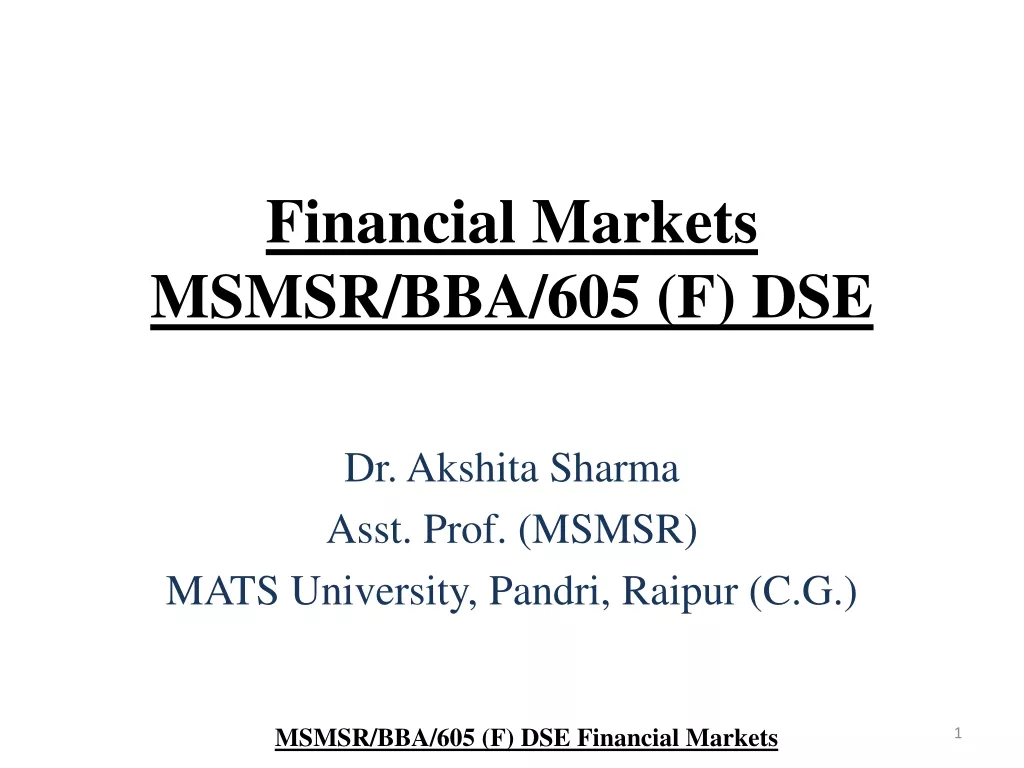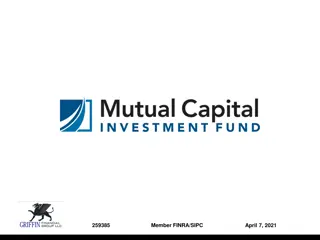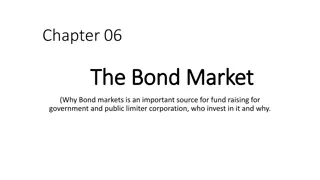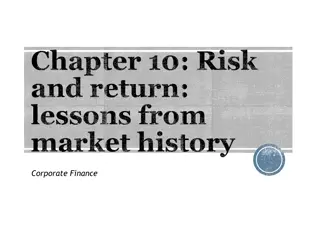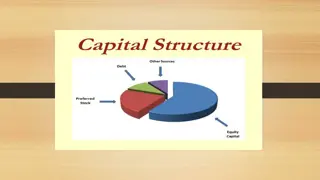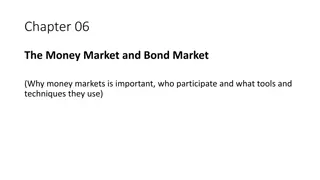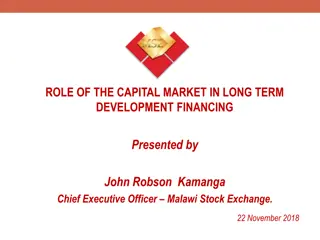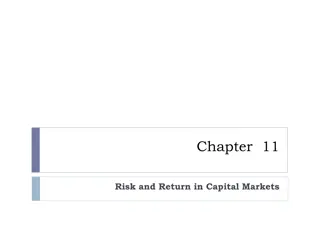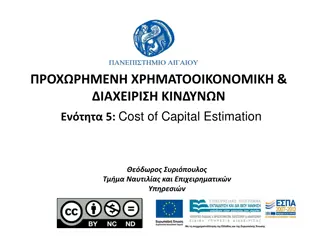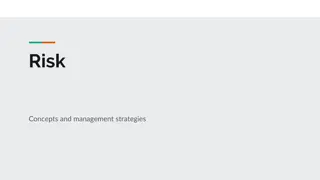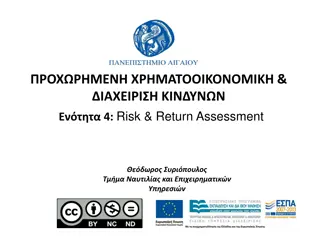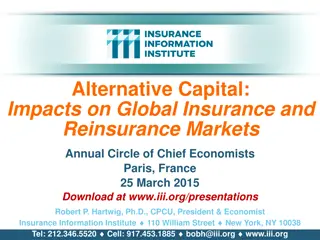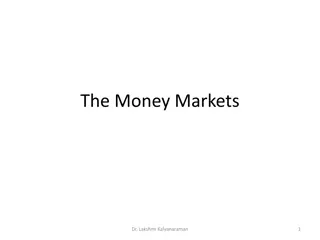Risk and Return in Capital Markets
Delve into the world of capital markets with Professor Droussiotis as you explore the concepts of risk and return. Discover how to measure expected return, quantify risk, and make strategic investment decisions. Learn about the factors influencing the value line in finance, including various risks and strategies to mitigate them.
Download Presentation

Please find below an Image/Link to download the presentation.
The content on the website is provided AS IS for your information and personal use only. It may not be sold, licensed, or shared on other websites without obtaining consent from the author.If you encounter any issues during the download, it is possible that the publisher has removed the file from their server.
You are allowed to download the files provided on this website for personal or commercial use, subject to the condition that they are used lawfully. All files are the property of their respective owners.
The content on the website is provided AS IS for your information and personal use only. It may not be sold, licensed, or shared on other websites without obtaining consent from the author.
E N D
Presentation Transcript
Chapter 1 CAPITAL MARKETS LECTURE 1: RISK & RETURN OVERVIEW Professor Droussiotis
Expected Value Line Growth (Return) EXIT Risk-Free Rate ENTRY Initial Investment
Expected Value Line Growth (Return) EXIT Risk Premium Risk-Free Rate ENTRY Initial Investment
Expected Value Line Growth (Return) EXIT Risk (Volatility) Risk Premium Risk-Free Rate ENTRY Initial Investment
THE STUDY OF FINANCE Buying Stocks / Buying Bonds Buying Assets / Equipment Starting a New Project Buying a Company Starting a new Company 3 FACTORS BEFORE YOU INVEST Measure Expected Return Quantify Risk Set Time (Exit)
THE STUDY OF FINANCE 3 FACTORS BEFORE YOU INVEST Game: Tossing a Coin to win $6 (Payoff): Measure Expected Return: $6 Quantify Risk: 50/50 win/loss Time: in 2 seconds Measure Expected Return Quantify Risk How much to Invest? $3 - mathematically using probability theory is (50% x $6) + (50% x $0) = Set Time (Exit) $3 + 0 = $3 Game: Tossing one dice to win $6 (Payoff): Measure Expected Return: $6 Quantify Risk: 1/6 to win, 5/6 to lose Time: in 2 seconds How much to Invest? $1 - mathematically using probability theory is (1/6 x $6) + (5/6 x $0) = $1 + 0 = $1
THE STUDY OF FINANCE FIELDS OF FINACE Corporate Finance Investment Analysis Credit Analysis Risks that are pushing the Value Line down EXIT Risk (Volatility) Expected Value Line Growth (Return) Finance Strategies to Keep the Value Line Up Initial Investment ENTRY 3 FACTORS BEFORE YOU INVEST Measure Expected Return Quantify Risk Set Time (Exit)
THE STUDY OF FINANCE Corporate Finance Risks that are pushing the Value Line Down: Economy Competition Government Disasters Other Systemic/Firm Specific Risks Strategies to Keep the Value Line Up Operating Strategies Transactional Strategies Financing Strategies Social Responsibility
THE STUDY OF FINANCE Investments Risks that is pushing the Value Line Down: Economy and Markets Government & Regulation Liquidity Other Systemic/Firm and Asset Class Specific Risks Strategies to Keep the Value Line Up Allocation/Diversification Strategies Hedging Strategies (Using Derivatives)
THE STUDY OF FINANCE Credit Analysis Risks that is pushing the Value Line Down: Economy Government Other Systemic/Firm and Asset Class Specific Risks Strategies to Keep the Value Line Up Loan / Bond Structure Debt Capacity Analysis
THE STUDY OF FINANCE Finance, Investments and Credit Fundamental Analysis : Understanding Financial Statements Build Projections Corporate Valuations Transaction / Debt Capacity Analysis Technical Analysis Stock movements, Standard Deviation Comparative Analysis/ Regression Analysis and Correlation Portfolio Analysis measurements CAPM, Sharpe Ratio, Beta, Alpha, ASSET CLASS: EQUITY BONDS DERIVATIVES Behavioral Analysis
CHAPTER 1-FUNDAMENTAL CONCEPTS IN FINANCE Time Value of Money Excel formulas for calculating all five variables including the present value, future value, rate of return, time and cash flows or payments (represent set additional payments received during the investment): FV = PV ? + ?? , ?? ?+?? = PV (rate, years, payment, future value) or =pv(rate,nper,pmt,fv) =FV (rate, years, payment, -present value) or =fv(rate,nper,pmt,pv) =Rate (years, payment, - present value, future value) or =rate(nper,pmt,pv,fv) =Nper (rate, payment, - present value, future value) or =nper(rate,pmt,pv,fv) =Pmt (rate, years, -present value, future value) or =pmt(rate,nper,pv,fv) ?? = ? ? 1 ? = (?? ??) ?? (?? ??(?+?) ??) ? = FVA = CF + CF (1+i) + CF (1+i) (1+i) FVA = CF ( (?+?)? ? ) ? ? ? ?? ?? ?? ?? ?+?? ? PVA = (1+?)2 + (1+?)3+ ..+ (1+?)? PVA = CF (1+?)1+ ??1 (1+?)1+ ??2 (1+?)2+ ??3 (1+?)3+ ??? 1+?? .?? = ??? (1+?)? PV =
CHAPTER 1-FUNDAMENTAL CONCEPTS IN FINANCE Rates of Return HPR = ?? ? IRR
Measuring Return and Return Expectation Before you invest your money in any securities or any businesses, it s extremely important to consider and must measure the following four factors: 1. Return expectation 2. Risk 3. Allocation 4. Time
LEARNING OBJECTIVES 1. After reading this chapter, students will be able to do the following: 2. Understand the component that make time value of money (TVM) including the calculations of present value (PV), future value (FV), interest rate (i) and time (t) for a one-time investment, annuity or uneven cash receipts. 3. Compute various measures to calculate the historical and expected returns on many asset classes such as equities and bonds 4. Quantify the risk on these asset classes by calculating the variance and standard deviation 5. Understand how to measure past performances of stocks and bonds using both historical analysis and scenario analysis to determine the expected risk/return going forward 6. Construct a portfolio of investments consisting of stocks, bonds, and risk-free investments such as cash, money market, or treasury bills and the impact of diversification 7. Understand portfolio optimization and efficiency based on asset allocation between stock, bonds, and cash

 undefined
undefined





